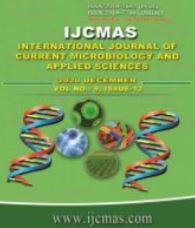


 National Academy of Agricultural Sciences (NAAS)
National Academy of Agricultural Sciences (NAAS)

|
PRINT ISSN : 2319-7692
Online ISSN : 2319-7706 Issues : 12 per year Publisher : Excellent Publishers Email : editorijcmas@gmail.com / submit@ijcmas.com Editor-in-chief: Dr.M.Prakash Index Copernicus ICV 2018: 95.39 NAAS RATING 2020: 5.38 |
Geospatial technique were used for land and water management action plan for Devanayakanahalli micro-watershed lies between 760 39' 43'' to 760 41' 17'' E longitudes and 130 4' 54'' to 130 6' 29'' N latitudes in Tumkur district, Karnataka. Arc GIS software was used in evaluation of morphological characteristics of the micro-watershed. The present study reveals that drainage pattern was dendritic with trunk order 3. The area, perimeter, maximum length and width of the micro-watershed are 453 ha, 10.10 km, 3.68 km and 1.23 km respectively. The mean value of bifurcation ratio was 2.20, it indicates micro-watershed had suffered less structural disturbance. The value of drainage density 2.30 km km-2 which shows that the region having permeable subsoil material. The value of form factor illustrates micro-watershed was elongated in shape. The study were used to prepare the thematic maps of land use/land cover, soil, slope and drainage using satellite imagery data and Survey of India (SoI) toposheet of micro-watershed and to integrate all the maps under GIS environment to prepare the water resource management plans for micro-watershed. The study will be helpful in identification of sites for construction of different soil and water conservation structures. Thus, the results shows that 38.14 per cent of the total area is ideal for constructing check dam, 20.97 per cent farm pond and 13.40 per cent for percolation pond which helps in sustainable development of the natural resources of the micro-watershed with the proper implementation of the proposed action plans.
 |
 |
 |
 |
 |